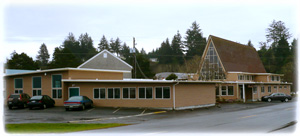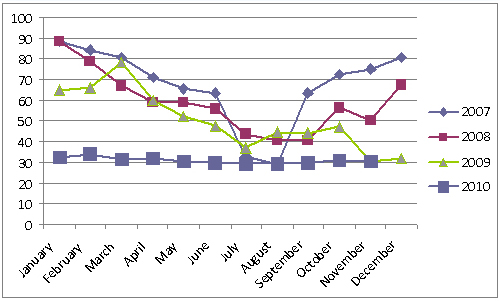Another Church $aves
Another Church Saving Big? But are their benefits being maximized? The answer may surprise you...
February 2011
 Waldport Community Presbyterian Church
Waldport Community Presbyterian ChurchWaldport, OR |
It's no secret that churches happen to be one of the best applications for demand management. The primary reason they're so successful can be attributed to their very predictable peaks of energy use compressed into short periods of time. As you can imagine, these peaks usually occur Sunday mornings when services take place. In October of 2009, one of our 9388C Energy Sentry units was installed at a church in Waldport, Oregon. They have had tremendous results with lowering their electric bills by reducing their kW. |
|
Waldport Community Presbyterian Church (WCPC) had been working on making small energy improvements throughout their building for years. Things like switching out incandescent light bulbs for CFLs, or ensuring the lights are off in vacant rooms. However, they were striving to make a much more significant impact on their electric costs. Gene Davis, a member of WCPC, came across the Energy Sentry website and felt an Energy Sentry demand management system would be able to do just that. Being a retired engineer, he was able to discuss their situation with Bill Brayden (President of Brayden Automation), install the 9388C, and set the load priorities himself. The main loads being controlled are:
By using the 9388C to manage their main electric loads, the church has been able to cut their electric bill nearly in half! They're paying 45% less on their bill than in 2007 and 2008 thanks to the Energy Sentry. We love seeing results like this because it proves how successful demand management can be for people with low load factor percentages. | |
 This graph compares WCPC's Demand (kW) Usage between 2007 to 2010
This graph compares WCPC's Demand (kW) Usage between 2007 to 2010
| |
However, there has been a downside for WCPC. We feel it is important to mention this so that our customers are aware of issues they may be able to fix. Elliot Estes, another member of the WCPC responsible for the building and grounds, has been receiving complaints regarding temperature issues within the building. Several of the members have been too cold during services in the winter time. After discussing this further with Elliot, we reviewed their usage history and identified that the demand limit was most likely too low for the level of comfort desired during the winter season. There are three main issues coming into play; building design, insulation, and low demand limit. Our first recommendation was to increase the Energy Sentry's demand limit during the high-use months to maintain comfort. |
|
 |
For demand management to accomplish the goal of saving money without affecting comfort, the building needs to be able to store thermal energy. In the winter time you want to keep warm air in, and in the summer time you want to keep the cool air in. If you're building does not store thermal energy well, then you're going to need to use more energy to achieve the desired temperature. This makes it very difficult for the Energy Sentry to do its job without effecting comfort. To that end, stopping air infiltration and thermal losses will help the demand management system. |
|
The following details some ways WCPC or any other church can improve heating issues in their building: Building Design
Good Insulation
Demand Limit
| |
